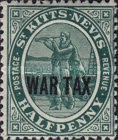As the 4th August 2014 commemorated the centenary of the start of World War One it is interesting to note the only mention of the commemoration was made by the Governer of Anguilla, Christina Scott, in 'The Anguillan', dated 1st August 2014.
The First World War 100 years on: why we should remember.
Next Monday, the fourth of August 2014 marks the 100th anniversary of Britain’s entry into the First World War. In the United Kingdom and across the battlefields of Europe, events will commemorate the centenary, and remember all those who lost their lives, from all sides, between 2014 and 2018.In Glasgow, a major Commemoration Service will take place in the city’s magnificent Cathedral, consecrated in 1197, and which has seen more than 800 years of continuous worship under one roof. The solemn service will bring together royalty and political leaders from Europe, as well as leaders from across the Commonwealth and Overseas Territories. The Chief Minister will represent Anguilla.
Although many think of the First World War as a conflict which took place in Europe, it covered four continents and three oceans. Among those who took part were thousands of soldiers from the Caribbean, many of whom fought with distinction and were awarded for their bravery.
There are records of soldiers and sailors from the Caribbean having fought for Britain since the 18th century and there had been a West Indian Regiment since 1790. Soldiers from the West Indies had fought with honour, including Private Samuel Hodge, who was the first black soldier to be awarded the Victoria Cross, in 1866.
At the start of the First World War, a battalion of the West India Regiment was stationed in Africa where they fought in the campaign to take the German colony in Cameroon. In 1915 the British Government formed a second unit made up of volunteers from the Caribbean which was named the British West Indies Regiment. Mostly this was made up of men who had made their way to Britain and had joined various military units. They saw action in modern day Kenya and Tanzania, where they took part in the successful battle to take control of Dar es Salaam, and then fought in Jordan and Palestine against the forces of Turkey. Later, in Europe, they saw service in France, Flanders and Italy.
Whilst most officers in the British West Indies Regiment were transferred in from other units of the British army, some officers with proud Caribbean roots served in the British army itself. Perhaps most famous of these is Walter Tull, whose father came from Barbados, and who played football for Tottenham Hotspur and Northampton Town before the start of the war. He was commissioned from the ranks in 1917 but tragically died before the end of the war after serving in Italy and France. A statue to his memory stands outside the ground of Northampton Town Football Club.
It wasn’t just the army in which men from the Caribbean served. William Robinson Clarke joined the Royal Flying Corp as a flight engineer and then flew as a pilot from 1917. Others served in the Royal Navy and saw service in engagements such as the Battle of Coronel off the coast of Chile and at the Battle of Jutland, the largest naval battle of the war. It is thought that up to 19,000 men from the Caribbean served in the armed forces of Britain from 1914 to 1918. Eighty-one medals were won for bravery of which sixty-one were awarded to officers and men of the British West Indies Regiment.
Anguilla too made its contribution. Private Peter A. Carter was one of at least two Anguillians known to have fought in the First World War. The other was Johnson Emile Gumbs. There may also have been a third. Peter left Anguilla in 1915 for Britain where he underwent four months of rigorous training before joining the British West Indies Regiment in campaigns in France and Italy.
In 1917 the unit in which Peter was serving was bombed by German warplanes. His foxhole was covered with debris and he was presumed dead having been missing for three days. Peter managed to dig himself out of his foxhole and was lucky to survive with only a wounded left leg in which a piece of shrapnel was embedded and which remained there until his sad passing in 1974. Peter was the only member of his unit to survive the bombing on that fateful day. He was the recipient of two medals: the Victory Medal and the British War Medal.
As the fourth of August approaches, and as we remember the men and woman who died in the war which it was hoped would end all wars, it is right that we pause to reflect on the sacrifices made by those from Anguilla and across the Caribbean. They travelled thousands of miles to serve a country that most had never seen. Their courage and commitment, and defence of the freedoms that we enjoy today, should not be forgotten.
HE The Governor Christina Scott
(with grateful thanks to Colville Petty for information about Private Carter)
http://theanguillian.com/2014/08/the-first-world-war-100-years-on-why-we-should-remember/



